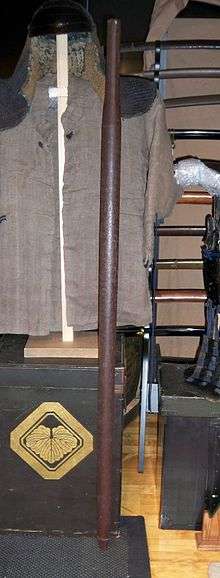Jō

A jō (杖:じょう) is an approximately 1.27-metre (4.2 ft) wooden staff, used in some Japanese martial arts. The martial art of wielding the jō is called jōjutsu or jōdō. Also, aiki-jō is a set of techniques in aikido which uses the jō to illustrate aikido's principles with a weapon. The jō staff is shorter than the bō. Today, the jō is still used by some Japanese police forces.
Legendary origin
The techniques for jō were reportedly invented by Musō Gonnosuke Katsuyoshi (夢想 權之助 勝吉, fl. c.1605, date of death unknown) after he was defeated by the famous swordsman, Miyamoto Musashi (宮本 武蔵, 1584–1645). They fought each other in a duel sometime between 1608 and 1611, according to Kenji Tokitsu. The record mentioning this duel, the Nitenki, recounts:
When Musashi was in Edo, he met an adept named Musō Gonnosuke, who asked to fight him. Gonnosuke used a wooden sword. Musashi was in the process of making a small Bo; he picked up a piece of firewood. Gonnosuke attacked him without even bowing, but he received a blow from Musashi that made him fall down. He was impressed and left.
A different text, the Kaijo Monogatari (dated to 1666) differs considerably from the Nitenki version. In it, Gonnosuke is a boastful and brash warrior who duels Musashi intending to see how Musashi compares with Musashi's father in swordsmanship. The fight occurs in Akashi, not Edo, and Gonnosuke wields a staff four shaku in length and reinforced with steel rings. After his defeat, he then went to Mount Homan-zan in Chikuzen (near Fukuoka), where he practiced considerably, changing his preferred weapon to four shaku and two sun in length - 1.27 meter as compared to 1.21 meter. This school was called the Shintō Musō-ryū because of Gonnosuke's previous training under Sakurai Osuminokami Yoshikatsu of the Shintō-ryū.
The school he founded to transmit his techniques has some old records which claims that Gonnosuke, struck by his defeat, went into solitary meditation until he received divine inspiration in a dream; he then invented techniques to fight against Musashi's two swords using only a stick, and defeated Musashi on their next encounter. Assuming the records are accurate and genuine, this would be the only time Musashi was defeated,[1] as the vast majority of documentation states that Musashi was never defeated.
Subsequent history
The usage of various stick weapons has existed in one form or another long before Musō Gonnosuke invented his techniques, but his school, Shintō Musō-ryū, was probably the first known professional school that dedicated itself to the art of using a jō against a swordsman.
Several traditional Japanese koryū ("old schools" of martial arts) used the jō like a sword. The added length of the jō was meant to give it an advantage over the sword. Further, its wood construction allowed a fighter to improvise a jō quickly from a tree, branch, or other pole.
In popular culture
- In The Book of Eli (2010), the titular character is shown carrying and defending himself using a jō staff, among other weapons. Jeff Imada choreographed the complex fight scenes, which feature the Filipino martial art of Kali. To play the lead role, Denzel Washington trained for months with Imada and Dan Inosanto.[2]
- In The Walking Dead season 5 Morgan is shown carrying a jō staff, and using it for self-defense and to kill zombies.[3][4] In the first two episodes of season 6, he is shown using it in the same ways, in addition to practicing with it and (reluctantly) to kill a human attacker.[5][6][7]
See also
| Wikimedia Commons has media related to Jō. |
References
- ↑ Hatsumi, Hatsumi and Chambers, Quinton (1971). Stick Fighting. Kodansha International Ltd., p. 9. ISBN 0-87011-475-1
- ↑ "The Book of Eli – Behind the Scenes:Stunts". Yahoo! Movies. Yahoo!. 2010.
- ↑ Venable, Nick. "The Walking Dead: Why Morgan Is Barely The Same Person Anymore". CinemaBlend. Retrieved October 22, 2015.
- ↑ McKee, Jonathan (April 3, 2015). "Season 5, Episode 16, Conquer". The Gospel According to The Walking Dead.
- ↑ Saclao, Christian (October 21, 2015). "'The Walking Dead' Season 6 Spoilers: Lennie James Teases Morgan's 90-Minute Flashback Episode". Design&Trend.
- ↑ McKee, Jonathan (October 20, 2015). "Season 6, Episode 2, J.S.S.". The Gospel According to The Walking Dead.
- ↑ McKee, Jonathan (October 12, 2015). "Season 6, Episode 1, First Time Again". The Gospel According to The Walking Dead.
Further reading
- Kenji Tokitsu (2004). Miyamoto Musashi: His life and writings. pp. 67–68. ISBN 1-59030-045-9.